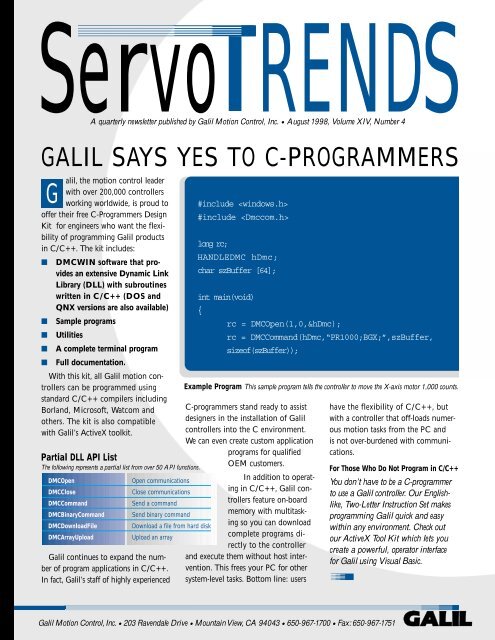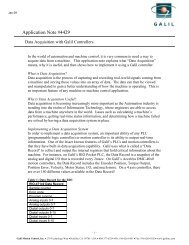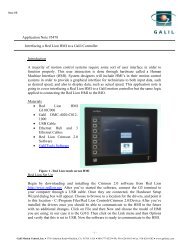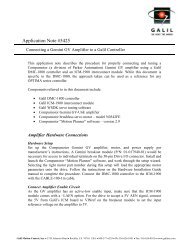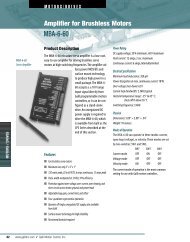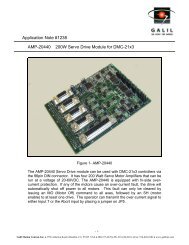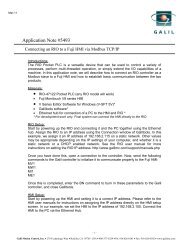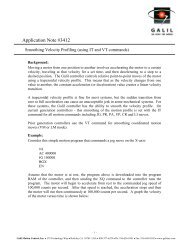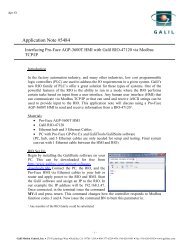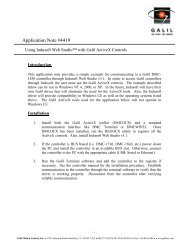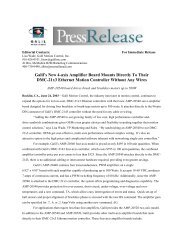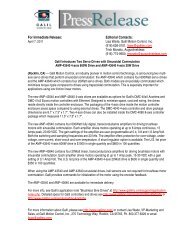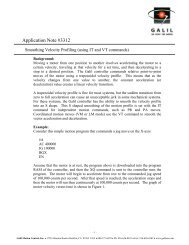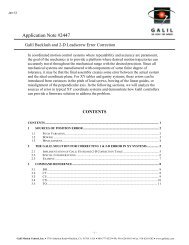GALIL SAYS YES TO C-PROGRAMMERS
GALIL SAYS YES TO C-PROGRAMMERS
GALIL SAYS YES TO C-PROGRAMMERS
You also want an ePaper? Increase the reach of your titles
YUMPU automatically turns print PDFs into web optimized ePapers that Google loves.
Servo RENDS<br />
A quarterly newsletter published by Galil Motion Control, Inc. • August 1998, Volume XIV, Number 4<br />
<strong>GALIL</strong> <strong>SAYS</strong> <strong>YES</strong> <strong>TO</strong> C-<strong>PROGRAMMERS</strong><br />
G<br />
#include <br />
alil, the motion control leader<br />
with over 200,000 controllers<br />
working worldwide, is proud to<br />
offer their free C-Programmers Design<br />
Kit for engineers who want the flexibility<br />
of programming Galil products<br />
in C/C++. The kit includes:<br />
■ DMCWIN software that provides<br />
an extensive Dynamic Link<br />
Library (DLL) with subroutines<br />
written in C/C++ (DOS and<br />
QNX versions are also available)<br />
■ Sample programs<br />
■ Utilities<br />
■ A complete terminal program<br />
■ Full documentation.<br />
With this kit, all Galil motion controllers<br />
can be programmed using<br />
standard C/C++ compilers including<br />
Borland, Microsoft, Watcom and<br />
others. The kit is also compatible<br />
with Galil’s ActiveX toolkit.<br />
Partial DLL API List<br />
The following represents a partial list from over 50 API functions.<br />
DMCOpen Open communications<br />
DMCClose Close communications<br />
DMCCommand Send a command<br />
DMCBinaryCommand Send binary command<br />
DMCDownloadFile Download a file from hard disk<br />
DMCArrayUpload Upload an array<br />
Galil continues to expand the number<br />
of program applications in C/C++.<br />
In fact, Galil’s staff of highly experienced<br />
#include <br />
long rc;<br />
HANDLEDMC hDmc;<br />
char szBuffer [64];<br />
int main(void)<br />
{<br />
rc = DMCOpen(1,0,&hDmc);<br />
rc = DMCCommand(hDmc,“PR1000;BGX;”,szBuffer,<br />
sizeof(szBuffer));<br />
Example Program This sample program tells the controller to move the X-axis motor 1,000 counts.<br />
C-programmers stand ready to assist<br />
designers in the installation of Galil<br />
controllers into the C environment.<br />
We can even create custom application<br />
programs for qualified<br />
OEM customers.<br />
In addition to operating<br />
in C/C++, Galil controllers<br />
feature on-board<br />
memory with multitasking<br />
so you can download<br />
complete programs directly<br />
to the controller<br />
and execute them without host intervention.<br />
This frees your PC for other<br />
system-level tasks. Bottom line: users<br />
have the flexibility of C/C++, but<br />
with a controller that off-loads numerous<br />
motion tasks from the PC and<br />
is not over-burdened with communications.<br />
For Those Who Do Not Program in C/C++<br />
You don’t have to be a C-programmer<br />
to use a Galil controller. Our Englishlike,<br />
Two-Letter Instruction Set makes<br />
programming Galil quick and easy<br />
within any environment. Check out<br />
our ActiveX Tool Kit which lets you<br />
create a powerful, operator interface<br />
for Galil using Visual Basic.<br />
Galil Motion Control, Inc. • 203 Ravendale Drive • MountainView, CA 94043 • 650-967-1700 • Fax: 650-967-1751
If you’re going to the International<br />
Manufacturing Technology Show<br />
(IMTS 98), you can visit Galil Motion<br />
Control, who will be sharing<br />
Booth #3340 with CamSoft<br />
on September 9–16 at<br />
McCormick Place in Chicago.<br />
CamSoft is the recognized<br />
leader of PC-based machine<br />
tool kit software that can be<br />
customized for a variety of<br />
high- speed applications requiring<br />
2- to 8-axes. By combining powerful<br />
Galil controllers with intelligent<br />
CamSoft software, the machine tool<br />
This Fall, Dr. Jacob Tal, the<br />
acclaimed authority on motion control<br />
and President of Galil, continues to conduct<br />
his popular seminar, “Motion Control<br />
Made Easy.” The half-day seminar<br />
reviews the basics of programmable motion<br />
control, including the latest innovations<br />
and design techniques. Topics<br />
include: Description of Servo Elements,<br />
Motion Component Selection, Servo<br />
System Tuning, Motion Programming<br />
and Design Examples. New for 1998 is<br />
a segment on using Visual Basic with<br />
motion controllers.<br />
The seminar will be held in many<br />
locations across the United States<br />
SEE <strong>GALIL</strong> AT IMTS 98<br />
FALL 1998 SEMINAR–MOTION CONTROL MADE EASY<br />
2 ServoTrends • Galil Motion Control, Inc. • 800-377-6329<br />
industry has a ready solution for a wide<br />
range of high-speed applications.<br />
In addition to learning more about<br />
Galil’s controllers and Camsoft’s ma-<br />
chine tool software at Booth #3340,<br />
you and your colleagues are invited to<br />
meet Dr. Jacob Tal, President of Galil<br />
and Gary Corey, founder and President<br />
beginning October 5, 1998. The price<br />
is only $59 and attendees will receive<br />
a copy of Dr. Tal’s popular textbook,<br />
Step-by-Step Design of Motion Control Systems<br />
(a $25 value), Motion Component Selector<br />
Software (a $50 value) and a complete<br />
set of course notes. All the sessions run<br />
from 8:30 am sharp to 12:30 pm.<br />
Pre-registration is required. Because<br />
the seminars fill quickly, please register<br />
now by calling Galil at 800-377-6329<br />
and have your credit card number ready;<br />
or send payment today with the enclosed<br />
reply card. You’ll receive $10 off if you<br />
register before September 14,1998.<br />
<strong>GALIL</strong> DEVELOPS QNX DEVICE DRIVER<br />
Galil now offers QNX device<br />
drivers and programming libraries to<br />
support all Galil advanced motion<br />
controllers. QNX is the preeminent,<br />
real-time operating system for PCs.<br />
Galil’s QNX drivers can be installed<br />
as a Resource Manager object,<br />
making them tightly integrated<br />
within the QNX environment.<br />
Since 1980, developers have<br />
used QNX, a Unix-like operating<br />
system, to create embedded realtime<br />
applications. Now, Galil controllers<br />
are easily used within this<br />
operating system. Contact Galil<br />
at 800-377-6329 for more details.<br />
of CamSoft, at a reception from 5-8<br />
p.m. Monday, September 14 at the<br />
Hyatt Regency McCormick. They will<br />
be presenting “The Trends In PC-based<br />
CNC.” If you plan to attend,<br />
please RSVP by calling Galil at<br />
800-377-6329. If you are not<br />
attending IMTS 98, you’re welcome<br />
to talk directly with Jacob<br />
about your specific motion<br />
control challenges by calling<br />
him directly at Galil at 650-967-1700.<br />
Gary Corey can be reached at<br />
CamSoft at 909-674-8100.<br />
Seminar schedule is as follows:<br />
Monday, October 5, 1998<br />
Sunnyvale, CA<br />
Wednesday, October 7, 1998<br />
Costa Mesa, CA<br />
Monday, October 12, 1998<br />
Milwaukee, WI<br />
Tuesday, October 13, 1998<br />
Troy, MI<br />
Wednesday, October 14, 1998<br />
Etobicoke-Ontario, Canada<br />
Thursday, October 15, 1998<br />
Marlborough, MA<br />
Monday, October 19, 1998<br />
Saddlebrook, NJ<br />
Tuesday, October 20, 1998<br />
Independence, OH<br />
Wednesday, October 21, 1998<br />
Oakbrook, IL<br />
Thursday , October 22, 1998<br />
Phoenix, AZ<br />
Tuesday, November 3, 1998<br />
Wilsonville, OR<br />
Wednesday, November 4, 1998<br />
Issaquah, WA
GENERAL DUAL LOOP IMPROVES<br />
BACKLASH COMPENSATION<br />
By Jacob Tal<br />
B<br />
acklash between<br />
the motor and<br />
the sensor is one of<br />
the worst nightmares<br />
of the servo engineer, as it often leads<br />
to loop instability. Backlash exists with<br />
most mechanical devices. Most commonly,<br />
when a rotary motor drives a<br />
slide via a leadscrew, and the sensor is<br />
placed on the load. The common cure<br />
against backlash is the dual loop which<br />
utilizes two sensors. This method and<br />
it’s improved version are described<br />
below with some experimental results.<br />
Dual Loop<br />
This method employs two sensors<br />
which are placed on both the motor<br />
and the load. The compensation filter<br />
with the PID function is then divided<br />
into two parts as shown in Figure 1. The<br />
main loop is closed with the load sensor,<br />
and the PI terms of the filter are<br />
applied to that loop. The D term of the<br />
compensation, however, is applied to<br />
the motor encoder, resulting in a damping<br />
term which is based on the motor<br />
position. This control method has been<br />
used for years with a good degree of<br />
success. In the following section we<br />
describe an improved method.<br />
The General Dual Loop<br />
Now suppose that we divide the<br />
PID operation into I in the outer loop<br />
and PD in the inner loop, as shown in<br />
Figure 2. It appears that this approach<br />
offers a great improvement.<br />
The rationale here is that the inner<br />
loop, on its own, would be stable, as it<br />
uses the motor sensor. The outer loop,<br />
on the other hand, would definitely be<br />
unstable on its own, as it has only the I<br />
term, and the backlash. Fortunately, the<br />
motor can either be stable or unstable,<br />
depending on the relative influence of<br />
the two loops. As we can select the loop<br />
parameters, we can make the inner loop<br />
significantly stronger, so that it dominates<br />
the motor behavior. Indeed, experimental<br />
results show that this method<br />
leads to a stable response, regardless of<br />
the backlash size.<br />
The effect of the compensation<br />
method was tested by the following<br />
experiment. A motor with inertially<br />
matched load was coupled by a belt<br />
with a backlash of 8 degrees. This is<br />
an amount that is very large compared<br />
to most systems. The system was controlled<br />
three ways. The first method<br />
was a single loop based on the load<br />
sensor. The second was the standard<br />
dual loop and the third was<br />
the general dual loop. The loop<br />
behavior is characterized by three<br />
measures. First we describe the PID<br />
parameter for each case. Clearly, the<br />
higher the gain, the better the loop. Test<br />
results indicate that the general dual loop<br />
results in maximum gain. The second<br />
test was to move the load 20 degrees,<br />
and to measure the time it takes the system<br />
to stop precisely. Here we find that<br />
the single loop never made it. It takes<br />
the remaining methods 520 ms and<br />
142 ms respectively to accomplish that.<br />
Another method of evaluation is<br />
by measuring the system bandwidth.<br />
Here the results are 2 Hz, 70 Hz and<br />
280 Hz respectively. The test results are<br />
summarized in the table below which<br />
indicate clearly the superior behavior<br />
of the general dual loop.<br />
Parameter Single Loop Dual Loop General Dual Loop<br />
KD 6 200 800<br />
KP 4 9 50<br />
K 0 1 10<br />
Motion Time (ms) ∞ 520 142<br />
Bandwidth (Hz) 2 70 280<br />
R<br />
+<br />
∑ PI<br />
+<br />
∑ AMP MO<strong>TO</strong>R BACKLASH<br />
–<br />
–<br />
Figure 1<br />
D<br />
MO<strong>TO</strong>R<br />
ENCODER<br />
LOAD SENSOR<br />
R<br />
+<br />
∑ I<br />
+<br />
∑ AMP MO<strong>TO</strong>R BACKLASH<br />
–<br />
–<br />
Figure 2<br />
PD<br />
MO<strong>TO</strong>R<br />
ENCODER<br />
LOAD SENSOR<br />
LOAD<br />
LOAD<br />
Email: galil@galilmc.com • Galil Motion Control, Inc. • ServoTrends 3
NEW! MULTIPLE SETS OF COORDINATED AXES<br />
Galil’s newest firmware (Revision<br />
1.2) for the DMC-1700 ISA bus motion<br />
controller now allows for the execution<br />
of two sets of simultaneous<br />
coordinated motion. Here’s how it<br />
works: Two distinct vector coordinate<br />
systems defined as S and T can execute<br />
vector motion at the same time. The<br />
standard Galil commands for vector<br />
motion, such as VM, VP, and CR,<br />
apply to each coordinate system while<br />
a new command, CA, defines the coordinate<br />
system. Gearing to either set of<br />
coordinate systems is also possible.<br />
By having dual sets of coordinated<br />
motion, users can accomplish completely<br />
separate coordinated motion<br />
tasks with a single controller. It even<br />
handles more complex motion control<br />
applications such as collision avoidance.<br />
Controlling coordinated axes with<br />
a Galil motion controller is extremely<br />
powerful. Within a coordinate<br />
system, any 2D path<br />
can be described using a<br />
sequence of linear and arc<br />
segments. Very long moves<br />
are permitted because additional<br />
segments can be<br />
given to the controller even<br />
after the motion has started.<br />
The vector speed and acceleration<br />
can also be changed<br />
during motion. Special<br />
commands allow for feedrate<br />
override, ellipse scaling,<br />
speed ratioing, slowdown<br />
around corners and<br />
assigning speeds to particular<br />
segments. Gearing is<br />
allowed on top of the coordinated<br />
move which is useful<br />
for specifying 2D shapes<br />
on a moving conveyer belt.<br />
Example–Two sets of Coordinated Motion<br />
# G O ;Label<br />
DP*=0 ;Define Position for all axes to 0<br />
C A S ;Specify S plane of motion<br />
VMXY ;Specify Vector Motion with X and Y axes on S plane<br />
VP -4000,0 ;Vector motion<br />
CR 1500,270,-180 ;Circular motion<br />
VP 0,3000 ;Vector motion<br />
CR 1500,90,-180 ;Circular motion<br />
VE ;End Vector Sequence for S plane<br />
C A T ;Specify T plane of motion<br />
LM ZW ;Specify Linear Interpolation with Z and W axes on T plane<br />
LI ,,-4000,0 ;Linear Interpolation point<br />
LI ,,-1500,1500 ;Linear Interpolation point<br />
LI ,,1500,1500 ;Linear Interpolation point<br />
LI,,4000,0 ;Linear Interpolation point<br />
LI,,1500,-1500 ;Linear Interpolation point<br />
LI,,-1500,-1500 ;Linear Interpolation point<br />
LE ;End Linear Interpolation Sequence for T Plane<br />
VA 50000,25000 ;Set Accelerations; 50000 for S plane, 25000 for T plane<br />
VD 50000,25000 ;Set Decelerations; 50000 for S plane, 25000 for T plane<br />
VS 10000,5000 ;Set Speeds; 10000 for S plane, 5000 for T plane<br />
BGST ;Begin Motion on S and T planes<br />
AMST ;Wait for motion complete on S and T planes<br />
EN ;End program<br />
S (xy) and T (zw) motion path<br />
Galil Motion Control, Inc. • 203 Ravendale Drive • MountainView, CA 94043 • 650-967-1700 • Fax: 650-967-1751


